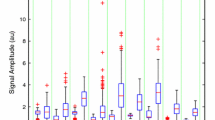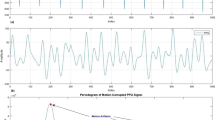Abstract
We introduce a new method to reconstruct motion and noise artifact (MNA) contaminated photoplethysmogram (PPG) data. A method to detect MNA corrupted data is provided in a companion paper. Our reconstruction algorithm is based on an iterative motion artifact removal (IMAR) approach, which utilizes the singular spectral analysis algorithm to remove MNA artifacts so that the most accurate estimates of uncorrupted heart rates (HRs) and arterial oxygen saturation (SpO2) values recorded by a pulse oximeter can be derived. Using both computer simulations and three different experimental data sets, we show that the proposed IMAR approach can reliably reconstruct MNA corrupted data segments, as the estimated HR and SpO2 values do not significantly deviate from the uncorrupted reference measurements. Comparison of the accuracy of reconstruction of the MNA corrupted data segments between our IMAR approach and the time-domain independent component analysis (TD-ICA) is made for all data sets as the latter method has been shown to provide good performance. For simulated data, there were no significant differences in the reconstructed HR and SpO2 values starting from 10 dB down to −15 dB for both white and colored noise contaminated PPG data using IMAR; for TD-ICA, significant differences were observed starting at 10 dB. Two experimental PPG data sets were created with contrived MNA by having subjects perform random forehead and rapid side-to-side finger movements show that; the performance of the IMAR approach on these data sets was quite accurate as non-significant differences in the reconstructed HR and SpO2 were found compared to non-contaminated reference values, in most subjects. In comparison, the accuracy of the TD-ICA was poor as there were significant differences in reconstructed HR and SpO2 values in most subjects. For non-contrived MNA corrupted PPG data, which were collected with subjects performing walking and stair climbing tasks, the IMAR significantly outperformed TD-ICA as the former method provided HR and SpO2 values that were non-significantly different than MNA free reference values.




Similar content being viewed by others
References
Bishop, G and G. Welch. An Introduction to the Kalman Filter. Tech. Rep, 2006.
Choi, S., A. Cichocki, H. Min Park, and S. Young Lee. Blind source separation and independent component analysis: a review. Neural Inf. Process. Lett. Rev. 6:1–57, 2004.
Chon, K. H., S. Dash, and K. Ju. Estimation of respiratory rate from photoplethysmogram data using time-frequency spectral estimation. IEEE `Trans. Bio-med. Eng. 56:2054–2063, 2009.
Comon, Pierre. Independent component analysis, a new concept? Signal Process. 36:287–314, 1994.
Diniz, P. Adaptive Filtering: Algorithms and Practical Implementation. Berlin: Springer Science, Business Media L.L.C., 2008.
Elsner, J. B., and A. A. Tsonis. Singular Spectrum Analysis: A New Tool in Time Series Analysis. Berlin: Springer, 1996.
Feleppa, J., and E. J. Mamou. Singular spectrum analysis applied to ultrasonic detection and imaging of brachytherapy seeds. Acoust. Soc. Am. 21:1790–1801, 2007.
Gao, J., C. Zheng, P. Wang. Online removal of muscle artifact from electroencephalogram signals based on canonical correlation analysis. Clin. EEG Neurosci. 41(1):53–59, 2010.
Ghaderi, F., H. R. Mohseni, and S. Sanei. Localizing heart sounds in respiratory signals using singular spectrum analysis. IEEE Trans. Biomed. Eng. 58:3360–3367, 2011.
Golyandina, N., V. Nekrutkin, and A. A. Zhigljavsky. Analysis of Time Series Structure: SSA and Related Techniques. London: Taylor & Francis, 2001.
Hamilton, P. S., M. G. Curley, R. M. Aimi, et al. Comparison of methods for adaptive removal of motion artifact. In: Computers in Cardiology 2000, pp. 383–386, 2000.
Hassani, H. Singular spectrum analysis: methodology and comparison. J. Data Sci. 5:239–257, 2007.
Jolliffe, I. T. Principal Component Analysis. Berlin: Springer, 1986.
Jubran A. Pulse oximetry. In: Applied Physiology in Intensive Care Medicine, edited by G. Hedenstierna, J. Mancebo, L. Brochard, et al. Berlin: Springer, pp. 45–48.
Kalman, R. E. A new approach to linear filtering and prediction problems transactions of the ASME. J. Basic Eng. Ser. D 1:2, 1960.
Kim, B. S., and S. K. Yoo. Motion artifact reduction in photoplethysmography using independent component analysis. IEEE Trans. Biomed. Eng. 53:566–568, 2006.
Kloeden, P. E., and E. Platen. Numerical Solution of Stochastic Differential Equations. Berlin: Springer, 1992.
Krishnan, R., B. Natarajan, and S. Warren. Two-stage approach for detection and reduction of motion artifacts in photoplethysmographic data. IEEE Trans. Biomed. Eng. 57:1867–1876, 2010.
Morbidi, F., A. Garulli, D. Prattichizzo, et al. Application of Kalman filter to remove TMS-induced artifacts from EEG recordings. IEEE Trans. Control Syst. Technol. 16:1360–1366, 2008.
Ram, M. R., K. V. Madhav, E. H. Krishna et al. Use of multi-scale principal component analysis for motion artifact reduction of PPG signals. Recent Advances in Intelligent Computational Systems (RAICS), 2011 IEEE. pp. 425–430, 2011.
Ram, M. R., K. V. Madhav, E. H. Krishna, et al. ICA-based improved DTCWT technique for MA reduction in PPG signals with restored respiratory information. IEEE Trans. Instrum. Meas. 62:2639–2651, 2013.
Reddy, K. A., B. George, N. Madhu Mohan et al. A novel method of measurement of oxygen saturation in arterial blood. Instrumentation and Measurement Technology Conference Proceedings, 2008 IMTC 2008 IEEE, pp. 1627–1630, 2008.
Reddy, K. A., B. George, N. M. Mohan, et al. A novel calibration-free method of measurement of oxygen saturation in arterial blood. IEEE Trans. Instrum. Meas. 58:1699–1705, 2009.
Seyedtabaii, S. and L. Seyedtabaii. Kalman Filter Based Adaptive Reduction of Motion Artifact from Photoplethysmographic Signal, Vol. 37. World Academy of Science, Engineering and Technology, 2008.
Sweeney, K. T., T. E. Ward, and S. F. Mcloone. Artifact removal in physiological signals—practices and possibilities. IEEE Trans. Inf. Technol. Biomed. 16:488–500, 2012.
Teixeira, A. R., A. M. Tomé, E. W. Lang, et al. Automatic removal of high-amplitude artefacts from single-channel electroencephalograms. Comput. Methods Programs Biomed. 83:125–138, 2006.
Thakor, N. V., and Y.-S. Zhu. Applications of adaptive filtering to ECG analysis: noise cancellation and arrhythmia detection. IEEE Trans. Biomed. Eng. 38:785–794, 1991.
Thompson, B. Canonical Correlation Analysis: Uses and Interpretation. Thousand Oaks: SAGE Publications, 1984.
Acknowledgments
This work was supported in part by the US Army Medical Research and Materiel Command (USAMRMC) under Grant No. W81XWH-12-1-0541.
Author information
Authors and Affiliations
Corresponding author
Additional information
Associate Editor Tingrui Pan oversaw the review of this article.
Rights and permissions
About this article
Cite this article
Salehizadeh, S.M.A., Dao, D.K., Chong, J.W. et al. Photoplethysmograph Signal Reconstruction based on a Novel Motion Artifact Detection-Reduction Approach. Part II: Motion and Noise Artifact Removal. Ann Biomed Eng 42, 2251–2263 (2014). https://doi.org/10.1007/s10439-014-1030-8
Received:
Accepted:
Published:
Issue Date:
DOI: https://doi.org/10.1007/s10439-014-1030-8




